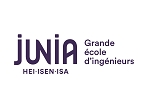Establishment
Language of instruction
English, French
Teaching content
MB-ST
This course occurs in the following program(s)
Training officer(s)
V.SENEZ, C.TARHAN
Stakeholder(s)
L.BUCHAILLOT, V.SENEZ, C.TARHAN
Présentation
Prerequisite
The student is able to synthesize his knowledge in complementary scientific fields, mainly in physics and chemistry. This course is complementary to the course entitled: 'MEMS Applications : Biology & Clinics '. Basic knowledge in sensors and actuators as well as in microfabrication is not mandatory but help in the understanding of the presentations.
Goal
The goal of this course is to give the fundamentals for the design and fabrication of miniaturized system dedicated to life sciences, the so-called BioMEMS. By the end of the course, the student must be able to relate to the different scientific disciplines that encompass the BioMEMS field. The student should be able to identify tools required to fabricate BioMEMS devices using both traditional silicon microfabrication methodologies as well as the use of “soft” lithographic processes. They should illustrate applications of BioMEMS examples. They should be able to design devices for specifics applications and to choose a suitable physical mechanism to implement a function in key application areas within screening, diagnostics, monitoring, and therapy. He should be able to appraise the differences between a BioMEMS system and standard laboratory instruments performing similar tasks. Finally, the student should be able to combine knowledge from a new scientific discipline with that of its academic background. This will develop the skills required to master an interdisciplinary field and to construct the knowledge base required for subsequent specializations.
Targetted Skills: 31(311/313), 32(321/323), 34(342), 42(421), 146(1461), 1110(11103/11104)
Targetted Skills: 31(311/313), 32(321/323), 34(342), 42(421), 146(1461), 1110(11103/11104)
Presentation
W1. History of micro technologies (Vincent Senez - VS)
W2. Design concept at the micro scale (VS)
W3. Fundamentals of micromachining (Lionel Buchaillot - LB)
W4. Fundamentals of micromachining (LB)
W5. Principles of electro-mechanical actuation (LB)
W6. Modeling of BioMEMS and Microfluidics (VS)
W7. MEMS applications for automotive and consumers (LB)
W8. MEMS applications (towards biology and clinics) (Cagatay Tarhan - CT)
W2. Design concept at the micro scale (VS)
W3. Fundamentals of micromachining (Lionel Buchaillot - LB)
W4. Fundamentals of micromachining (LB)
W5. Principles of electro-mechanical actuation (LB)
W6. Modeling of BioMEMS and Microfluidics (VS)
W7. MEMS applications for automotive and consumers (LB)
W8. MEMS applications (towards biology and clinics) (Cagatay Tarhan - CT)
Modalités
Forms of instruction
Lectures and exercises. Some lectures are given as brief conferences when dealing with industrial presentation material. Projects may complete the content.
Organization
| Type | Amount of time | Comment | |
|---|---|---|---|
| Face to face | |||
| Lectures - face to face | 28,00 | ||
| Independent study | |||
| Independent study | 52,00 | ||
| Overall student workload | 80,00 | ||
Evaluation
Theoretical examination at the end of the course
Excercices during course (modeling and/or reading of scientific papers)
Excercices during course (modeling and/or reading of scientific papers)
Ressources
Bibliography
Introduction à la microfluidique - P. Tabeling -Belin
Gouttes, Bulles, Perles et Ondes - PG de Gennes, F. Brochard-Wyart, D. Quéré – Echelles
Microfluidics for Biotechnology - Jean Berthier et Pascal Siberzan – Microelectromechanical series
Fundamental and Applications of Microfluidics - Nam-Trung Nguyen and Steven Wereley - Microelectromechanical series
Gouttes, Bulles, Perles et Ondes - PG de Gennes, F. Brochard-Wyart, D. Quéré – Echelles
Microfluidics for Biotechnology - Jean Berthier et Pascal Siberzan – Microelectromechanical series
Fundamental and Applications of Microfluidics - Nam-Trung Nguyen and Steven Wereley - Microelectromechanical series






